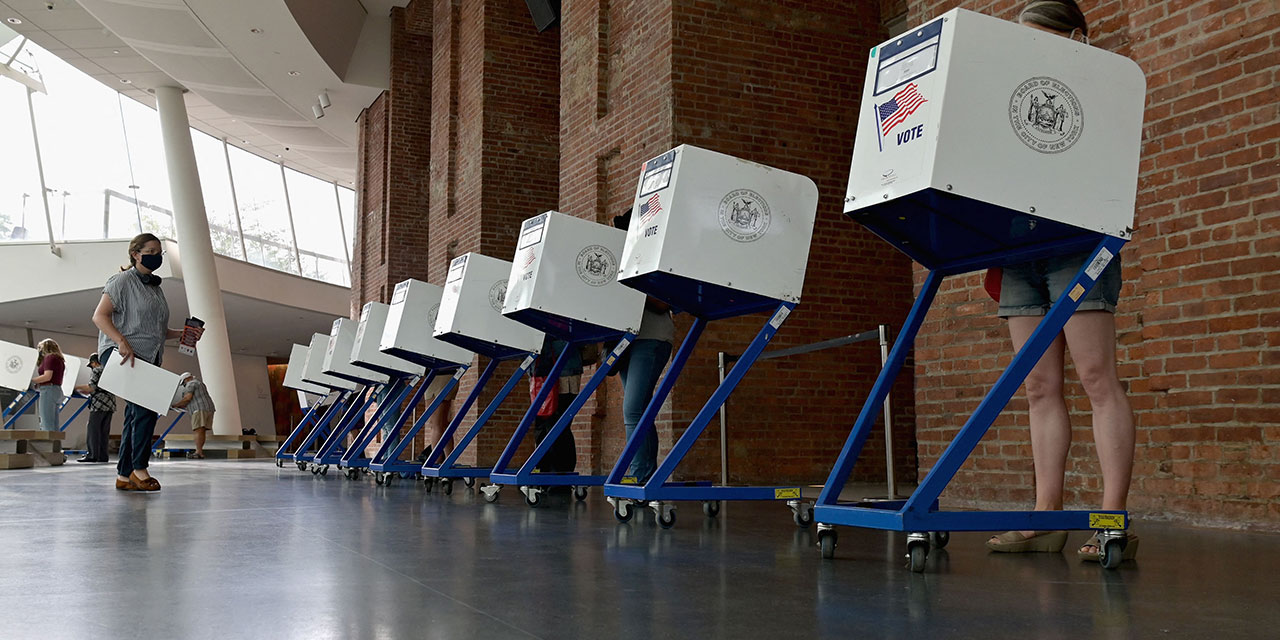
Five years after the Covid-19 pandemic began, urban America is still sick. In New York City, crime and disorder, soaring housing costs, and dysfunctional government have left only 14 percent of voters believing the city is headed in the right direction, according to a recent public opinion study. More than a quarter of New Yorkers are considering leaving or have already decided to do so.
But don’t expect this mounting discontent to shake up Gotham’s city council elections this year. Candidates from rival factions of the major parties will compete as usual. Progressive activists and special interests will again have outsize influence in the Democratic primary, open only to registered party members. About 1 million unaffiliated voters won’t be able to vote in any primary. Come November, the general election will ratify Democrats in almost every council district, thanks to the party’s overwhelming enrollment advantage.
To escape this malaise, New York and other cities need electoral reform. Fortunately, the city’s 2025 Charter Revision Commission (CRC) provides an opportunity to achieve much needed change.
In a new Manhattan Institute report, political scientist Jack Santucci and I propose list-based proportional representation as a way to foster pro-growth factions from both major parties into legislative majorities. The CRC should consider these list systems, alongside other reforms.
Finally, a reason to check your email.
Sign up for our free newsletter today.
Currently, each of the city council’s 51 members are elected via single-seat districts in low-turnout, odd-year elections. This structure gives special interests like public-sector unions inordinate power to influence elections through their political activities and by getting out their members to vote. Neighborhood interests like anti-growth homeowners also have an upper hand in single-seat council districts.
Several interconnected reforms could get the Big Apple closer to a competitive local party system. First, moving to even-year local elections would dramatically boost voter turnout, leading to a more representative electorate. Expanded turnout would also reduce the influence of special interests by making it harder to reach enough voters to sway council elections.
Several alternatives can replace the city’s closed primaries. While open or nonpartisan primaries are common options that allow all registered voters to participate, another alternative could eliminate primaries for council races altogether. In party-list proportional representation (PR) systems, parties nominate candidates by whatever internal process they prefer. Depending on the type of list system, voters can select a party, a party’s candidate, or both. For example, under a “one-vote” system, a vote for a party’s candidate counts for the party and the candidate. If the party secures enough votes to win one seat, then the candidate with the most votes from that party’s list claims the seat. Each district elects multiple councilmembers, with seats allocated in proportion to each party’s share of the vote. Under PR, a 40 percent vote share could translate into roughly 40 percent of the seats in that multi-seat district—allowing minority coalitions to gain a foothold rather than being shut out entirely.
Shifting to multi-seat districts would allow several councilmembers to be elected from each district. That way, a larger political coalition that’s currently spread thin across many small districts could consolidate its support and win multiple seats in a few larger districts. For instance, a pro-housing supply bloc that commands 40 percent of the vote citywide might fail to win many single-member races but could secure substantial representation in multi-seat districts.
Instead of New York’s one-party-fits-all system, proportional representation might make more parties viable. By broadening electoral districts to encompass wider geographies, local parties might craft more tailored messages to voters across neighborhoods, ensuring better representation for the overall electorate’s preferences.
Cities that wish to preserve single-seat districts can also achieve the benefits associated with PR through mixed-member proportional representation (MMP). This approach retains traditional single-member districts while also letting voters choose their preferred party. Candidates with the most votes in each district win their races, but the overall distribution of seats in the legislature is determined by the party vote. After district winners are decided, parties receive additional seats from their lists to ensure that the final makeup of the council reflects the proportion of party votes cast.
While no American state or locality currently uses MMP, it has worked well for decades in parliamentary elections in Germany and New Zealand. The London Assembly, the local body that oversees the Mayor of London, also uses a variant of this system. In MMP elections, two major parties usually secure large pluralities but must form majority coalitions with a handful of other parties. While the recent political turmoil in Germany may seem like reason not to follow its lead, most American cities, like New York, don’t use a parliamentary system; they elect a mayor (or other chief executive) separately.
In a city legislative context, there’s less need to produce a durable coalition that agrees across diverse policy domains. Various coalitions could form, depending on the proposal at hand. This would suit the local U.S. context well, given that city issues like transit or housing don’t align along a consistent ideological spectrum. For example, a party that prioritizes public transportation access and subway safety might win seats—and also support progressive climate legislation alongside tougher policing of crime and disorder. Likewise, a pro-housing party could prevent its members or coalition partners from blocking rezoning efforts. List PR ties politicians’ fates together and gives them a strong incentive to protect their party’s reputation while working alongside other parties to achieve their respective agendas.
Would a proportional representation system lead to a proliferation of small parties? Probably not. The rules can be designed to encourage smaller factions to align with broader coalitions. A key factor is district magnitude—the number of seats per district—which helps set the vote threshold required to win representation. Properly calibrated, this threshold can prevent fringe or single-issue groups from gaining a foothold.
Many of New York City’s councilmembers don’t reflect the views of their constituents. The 2025 CRC can change that. A party-list proportional representation system could help realign local government with public opinion—not only in New York, but in other major cities as well.
Photo by ANGELA WEISS/AFP via Getty Images
City Journal is a publication of the Manhattan Institute for Policy Research (MI), a leading free-market think tank. Are you interested in supporting the magazine? As a 501(c)(3) nonprofit, donations in support of MI and City Journal are fully tax-deductible as provided by law (EIN #13-2912529).
Source link

















